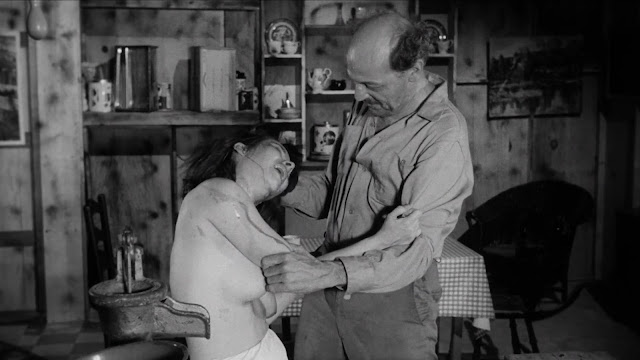
The Substance (Coralie Fargeat, 2024)
Our celebration of beauty and youth is hardly a new concept; they've been well documented in art, literature and music throughout our history. Achieving such perfection often comes at a high price. Coralie Fargeat critiques these impossible standards in the satirical body horror that is her sophomore film, The Substance (2024). All this, while waving the tricolore flag as the true queen of New French Extremity.
Much like her star on the Hollywood Walk of Fame, celebrity aerobics instructor Elizabeth Sparkle's career (Demi Moore) has lost its lustre. The knives are out for the fifty year old fitness guru. Eavesdropping her obnoxious slime boss Harvey (Dennis Quaid), the search is on for a young and attractive replacement for Elizabeth as she will be unceremoniously carted off to the knacker's yard. The distressing news leads to her being involved in a car accident. Whilst at the hospital, she learns from a member of staff there of a wonder treatment simply known as the Substance.


"Have you ever dreamt of a better version of yourself? Younger, more
beautiful, more perfect. One single injection unlocks your DNA, starting
a new cellular division, that will release another version of yourself.
This is the Substance. You are the matrix. Everything comes from you.
Everything is you. This is simply a better version of yourself. You just
have to share. One week for one and one week for the other. A perfect
balance of seven days each. The one and only thing not to forget: You.
Are. One. You can't escape from yourself."
Elizabeth's desperation leads to crawling below a roll shutter in a
dodgy backstreet alley where it leads to a brightly-lit, Kubrickian white room. With no other human interaction, this mysterious area is where Elizabeth obtains the black market miracle drug known as the Substance. Resembling
Herbert West's fluorescent green serum from Stuart Gordon's classic film Re-Animator
(1985), the wonder drug comes with a bunch of vacuum packed plastic
utensils that ordinarily be off-putting for anyone. The procedure is almost fetishistic adds and highlights the ridiculousness procedure involved to be young and beautiful again.


The film firmly arrives at destination body horror when Elizabeth injects the serum into her body, and in the first of many Cronenberg inspired scenes, gives birth to her younger and improved genetic double. The execution of this sequence is sublime. The mononymous Sue (Margaret Qually) is the Mr. Edward Hyde to Elizabeth's Dr. Henry Jeckyll. Whilst one of them is active, the other is in a catatonic state. Sue requires a daily stabiliser to keep going; essentially the spinal fluid she retrieves from Elizabeth.
While not stating the obvious, the pair are remarkably different in behaviour. While Elizabeth is timid and uncertain, Sue is confident and brash. People don't see Sue and bump into her without giving her a second look; her younger version has slack-jawed men dumbstruck by her beauty. Needless to say, she lands the aerobics job as Elizabeth's replacement. The Substance holds no restraint in its critique of society's idolisation with beauty and youth. Sue's aerobics show is far more lurid in comparison to her predecessor's routines. Stylistically speaking, it's evocative of the risqué dance music videos which were popular in the noughties. The camera is completely and utterly fixated over Sue's fit and supple body. No complaints from me.


At its core The Substance has a similar structure to Forgeat's impressive debut, Revenge (2017), as they both feature a small cast, along with being films which blend the fantastical with reality. This is all about satirising both the beauty and entertainment industries in an extreme fashion. For this reason, The Substance comes across as cartoonish on the surface, yet completely fathomable with our assumptions of these fields. The outrageousness style is further reinforced in the film's aesthetic production design, as well as its obnoxiously loud EDM soundtrack..
Possibly Demi Moore's best performance captured on film, as she's perfectly cast as an ageing beauty. The obvious cosmetic work on her face only reconfirms the film's commentary on our obsession with capturing our prime again. One scene in particular, where she's getting ready for a date, is almost as disturbing as the grotesque body horror scenes elsewhere in the film, as she's in complete distress trying to look good to validate herself. Her dysmorphia reveals her complete fragility as she tears at her hair and face in anguish. Qually, on the other hand, is equally effective playing the ultra desirable femme, since she also exhibits personality flaws as well; notably her greedy selfishness to extend her allotted seven days, which is detrimental to the older host which sustains her. Thus the Jeckyll and Hyde parallel becomes more symbiotic and extreme.


Fargeat takes a huge risk in the third act by going in a direction which might lose folk who didn't pick up on the film's intentional humour. Without giving away any spoiler details, the film goes completely off-the-rails, albeit in an outlandishly spectacular way; evoking notable films by Brian Yuzna and Brian De Palma. The icing on the cake is how it leads to a deeply poetic scene right before the end titles.
Regardless of the cinephile fodder which rear their heads around this season, The Substance is undoubtedly one of the biggest highlights for me this year. It won me over by completely catering to my love for genre cinema, and based on my observation at my screening, entertained me about as much as the turd wave feminists who were also in attendance. It earned my respect for putting a huge smile on my face, making its epic two hours and twenty minutes run time (which was admittedly off-putting, initially) completely fly by.
The Substance is a deeply impressive sophomore film and a grotesque work of art.












%20THE%20COFFEE%20TABLE%20trailer%202022%20-%20YouTube.png)






























